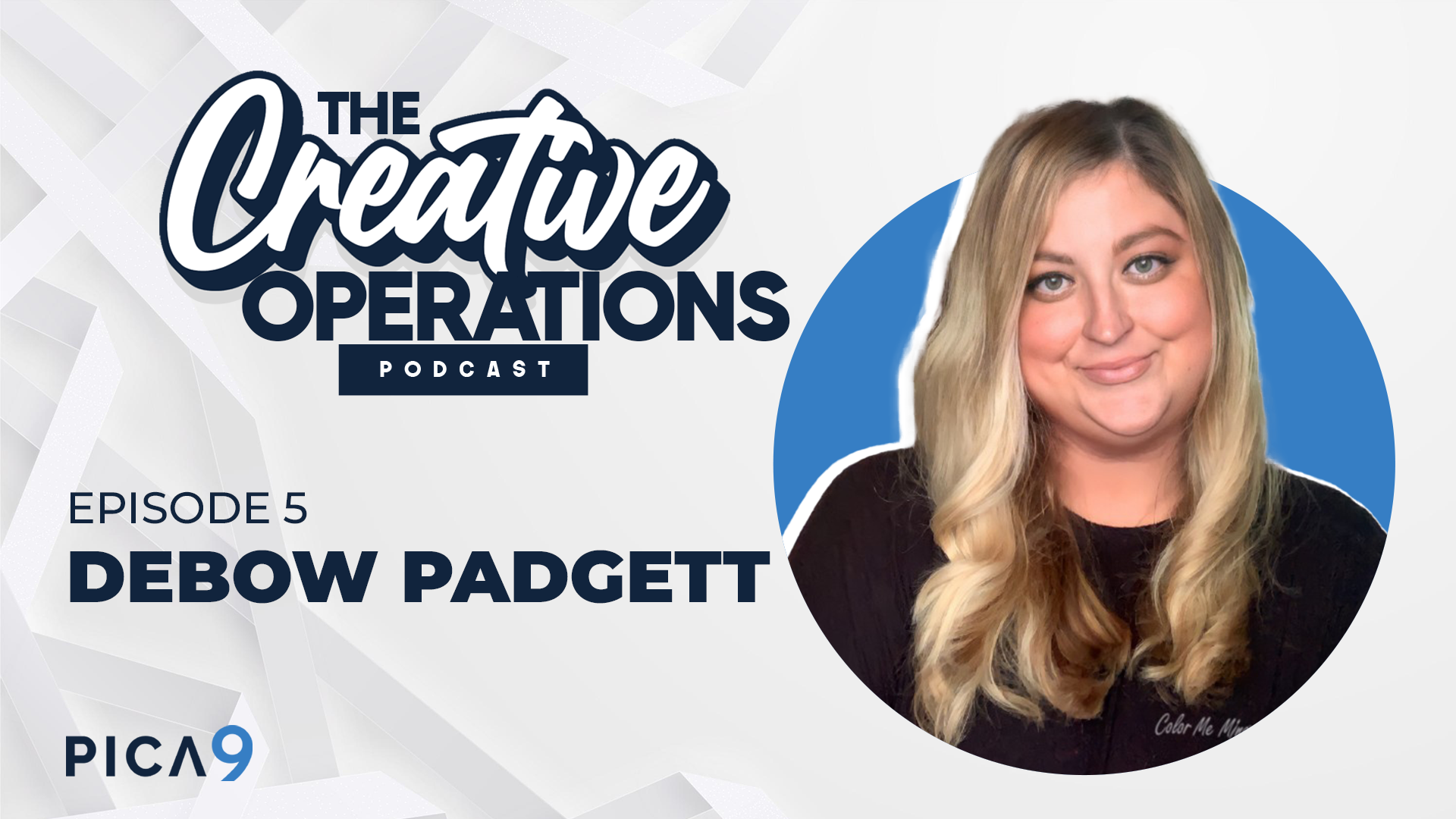The Creative Operations Podcast: Episode 1 - Get To Know Your Host
Pica9 founder and host of the new Creative Operations Podcast shares his experience working closely with distributed brands in scaling and improving in-house creative operations.
Tell us a little bit more about yourself. How'd you get where you are today?
My history in creative operations stems back to the beginning of my career as a copywriter. I was a partner in an agency with two delightful gents. One was creative ; the other was account. I was the copywriter and technology guy, and always the one coming up with ideas for getting us into trouble.
One day we went to visit one of the largest consulting firms in the world—with more than 2,000 locations. We were pitching them on a piece of business—and the pitch went really well. So, the account guy and I got in the car and he called our partner back at the office and said, "I've got good news and I've got bad news." So the CD says, "What's the good news?" And the account guy says, "We won the account"! And the CD says, "That's amazing. What's the bad news?" And the account guy says, "We won the account."
I mean, how on earth was our little shop supposed to serve 2,000 offices globally?"
And that's when I started looking for technologies to help us make creative operations scale.
So, fast forward a few years, we built a technology solution that allowed our in-house agency to support those 2,000 offices. And along the way, as we developed that technology, we learned a ton of things. For sure, we learned a lot about how to build software. But we learned even more about people, about folks at the local level, the regional level, the brand level. We began to see firsthand all the different problems and opportunities that each of these different kinds of operators faced every day.
And so our software began to evolve. And before you knew it, we had hundreds of customers on the system. That was beyond the first consulting customer. And, so we began to see that we didn't just have a studio. We had a product.
And that's how I got into this game.
So, tell me a little bit more about Pica9 today and where things are at?
Pica9 and its product CampaignDrive are one of the founding members of what we call the brand-to-local portal business. We're a New York-based organization, although now we're almost all remote. We serve about 150,000 local businesses and we're on the hunt to serve a million local businesses—through the brands that create the marketing materials and the brand assets that drive their operations.
So we're getting there, right? We're getting toward what we used to think of as an audaciously, huge, almost unattainable goal. And we're doing it with a really nimble team, starting with software developers, for sure. That's the beating heart of the business. But right next to it is a whole team of designers who have been experimenting for years with how to take beautiful branding elements and make them accessible to folks who don't have the kind of training and aesthetics that designers have.
So, we've been playing in these fields for quite a few years and we've learned a lot and we've had a lot of fun along the way. We've tried to embody that in our software and because of that our software is getting stronger, faster, and easier, literally every week.
So why the creative operations podcast, why now? and who is this for?
Creative operations has emerged as a discipline because the design profession itself has to become more democratic—more distributed. We work with a ton of in-house agencies for major brands and here's what we hear again and again.
We hear that they're overloaded with mechanical requests from the field, from their local franchisees, dealers, or resellers. They're so overwhelmed by those one-off requests that they don't have the time to do the work that they were trained to do: the high-level branding strategy, the creative work. They're pinned down by mechanical requests so that they can't get to those higher-level functions.
That's a painful place to be if you're a creative. Whether you're a copywriter or a designer or a brand manager, you're not really getting to do the stuff you enjoy the most.
But there's another person in that equation that you have to keep in mind: that's that local marketer him or herself. They might manage a restaurant manager. Or a hotel. They might own a small chain restaurant and have to do everything from running the cash register to hiring kitchen staff, to taking care of parking problems. And in the midst of all that, they need to get marketing done. And it turns out, very often, they don't have any formal skills or training, or background to know when a marketing task is really difficult and when it's more accessible, when something is on-brand and when it's off-brand.
Those are the folks that we are working to serve every single day. Those are the million-plus businesses.
And who this creative operations podcast is really for are the experts who spent their careers, building marketing intelligence, and branding intelligence, and design-skill and talent, and who need to bring all that to bear, so they can create assets for those folks in the field to use quickly and easily and without typical mistakes.
You know, one of the things we've seen a lot over the years besides those one-off requests is design teams or brand teams that just shake their head when they see what happened to their work. It makes me think of that old folk-tune, "Look what they've done to my song. It's the only thing I have right. And it's turning out all wrong".
Our creative operations folks—the ones that we really think about and empathize with every day—they feel that a lot. And our job, the job of our system, is to try and make sure that we protect their work while activating the brand at the same time.
I love how you brought up the fact that at the end of the day it's about the people and the interactions. How do we scale all these things and maintain the humanity around it? Even if it's enabled through technology, right, we still have to keep in mind that every small detail is going to have an impact.
You know, early in my career, we used to spend weeks—sometimes months—building brand binders. They were huge: eight inches thick and filled with everything: tear sheets, ad slicks, logo sheets, and all sorts of stuff. And they had tons and tons of beautiful copy about what the brand is meant to be. Its voice, its essence.
And of course, they had rules: tons of rules. Hundreds of rules about brand guidelines.
If you handed that binder to somebody who hadn't created it, very often, they would look at it as just a doorstop. They rarely even opened it. Number one, because it told them what not to do. It didn't enable them to get done what they needed to get done. And number two, because it spoke a language that they didn't themselves speak.
And so, we found those brand binders—which easily cost a quarter-million dollars to produce— never got read.
Our mission at Pica9 is to transform that brand binder into the following user experience. A local marketer walks up to his computer. He/she searches for a brand asset using language that she knows, that's natural to her. She finds the thing she's looking for and then customizes it to her immediate need without ever having the chance to make a mistake.
And when she hits the submit button, sometimes there's an approval loop, and other times it goes straight to production. We take a task that used to take days, weeks, or hours and we turn it into seconds or minutes. That's our job.
And when we get it right, what we see is that businesses accelerate. When you multiply that by 2,000 offices, all of which are now moving faster, more reliably, and with greater brand integrity, that's when businesses accelerate
It's important to note that by reducing the chance of creative error, we actually open up so much possibility at scale. We enable more creativity at a faster pace, reaching more people. And when it's being done effectively, it's turning the revenue dial at these individual locations. Meaning there is a real quantifiable impact happening here.
What do you hope happens with The Creative Operations Podcast?
We meet people all the time that are on this journey—and believe me, the local marketing acceleration game is definitely a journey.
What I hope with this podcast is that we meet people who are in the midst of that journey. Sometimes they've selected a solution and they're two years into really trying to get maximum value from it. Maybe they're just beginning to think about moving from manual processes. But what I hope they get from the podcast are concrete perspectives from people who are doing it and people who have done it. People who will talk to the human factor in creative operations, not just the technology factor.
Those attitudes and perspectives are the things we want to dive into. For sure, along the way, we'll talk about things like DAM and metadata. But you can learn about those things in a hundred different places. What I hope this podcast will uniquely talk about is the very human triangle at the heart of the brand-to-local equation. The brand steward, the local marketer and the local customer.
That triangle is filled with really rich human things to talk about. And that's what I hope we focus on. Because when you get that relationship right, you can use any combination of technology.
So Kevin, any closing thoughts before we wrap up today's podcast episode?
I guess, just one. It's that we don't want to take ourselves too seriously here. I mean, creative operations is something I've always loved. It's something you should love if you're going to be in the business.
But there's a theme I came across a long time ago and it was from that agency partner of mine, right at the very beginning. We talked about how brands often hang on to their brand integrity really, really closely. They think of themselves as the brand police. But, the theme my old CD used to share with me came from an old 38 Special song: "Hold on loosely, but don't let go". Don't let go of that blend that we find makes everybody in that triangle happy.
So, that's what we're going to try to do . We're going to hold on loosely to our thoughts and learnings in this category and then try not to let go of the central principles that make brand to local marketing work. That's it.
Click here to listen to The Creative Operations Podcast and subscribe to stay up-to-date on future episodes.





